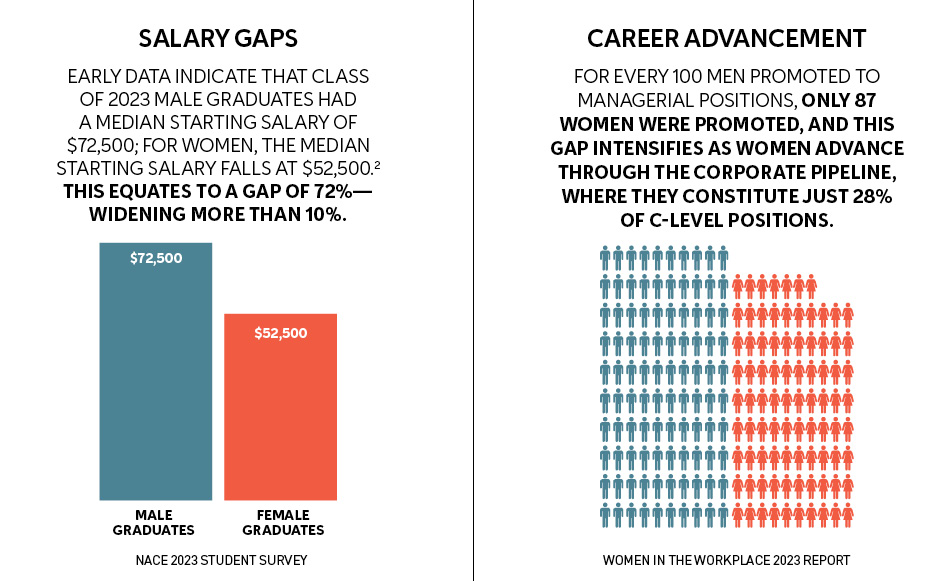NACE Journal / Winter 2024
Recent data reveal that systemic barriers continue to limit progress on achieving pay equity for all—yet there are tangible, proven ways that career centers and employers can make an impact.
The State of the Gender Pay Gap
Gender-based inequities remain a structural form of discrimination in our labor market. NACE’s First Destination Survey for the Class of 2022 , the most current outcomes report available, found that men continue to outpace women in terms of job outcomes and pay.1
NACE’s study found that men have a greater probability of obtaining full-time employment after graduation than do women. Specifically, the percent of men who entered the job market, as opposed to seeking military or community service or continuing education, was nearly 81%. By contrast, only 78% of women were similarly successful.
Further, the gender pay gap continues to be a form of systemic inequality in the labor market. For the Class of 2022, the average salary for women ($57,000) continued to be well below that for men ($69,000). In fact, the ratio between men and women continues to be approximately the same as it was in the mid-2010s and in 2020. For 2022, the average salary for a female graduate was 82.4% that of a male graduate’s average salary. However, the pay gap is exacerbated by the disparity in bonus compensation. Not only did a greater percentage of men receive a guaranteed bonus (32% of men versus 24% of women), but the average amount of that guaranteed bonus was also higher for men than women ($12,500 for men versus $9,270 for women). Combining all these elements, the adjusted average total compensation for female graduates amounted to just 78.2% of that for male graduates.

Looking ahead, we find that early data from NACE’s 2023 Student Survey indicate that Class of 2023 male graduates had a median starting salary of $72,500; for women, the median starting salary falls at $52,500.2 This equates to a gap of 72%—widening more than 10%. There are likely multiple factors that contribute to the gap, including major. For example, male students have higher representation in business and STEM majors than do women, while women have greater representation in liberal arts and public service majors. However, major doesn’t explain all the differences. Even within majors, men earn more than women. Recent 2022 U.S. Census Bureau data show that men have an earnings advantage across academic majors, regardless of whether they are predominately male or female dominated fields.3 Male computer science graduates (where men held 60% of the degrees) earned a median income of $115,500, while women earned $91,990. In academic majors where women comprise 70% of the students, women continue to trail men’s earnings. For instance, in social work, women earned 90% of what men earned, and in elementary education, women earned 84% of men’s salaries. This means that regardless of whether women are in gender-traditional or gender-nontraditional majors, they still face a wage gap.
Mitigating Gender Pay Disparity
As fields that have a greater composition of men have higher rates of pay than predominately female fields, one possible way to close the pay gap is for women to enter into predominately male fields. However, as our data show, this is not always so clear cut. Exploring equity gaps in STEM-related careers provides insight into how we can mitigate inequities across all fields and the work that still needs to be done.
Recently, NACE and Break Through Tech conducted research on the impact of career services for women pursuing STEM-related fields.4 The study found that:
- Undergraduate men in general get more job offers than undergraduate women, regardless of whether they use career services, but the use of career services helps narrow the gap between the two groups.
- When neither men nor women pursuing STEM majors use career services, men get more job offers than women.
- When both women and men in STEM majors use career services, women receive more job offers than men.
This important result holds for every type of career service studied, with the exception of the use of job postings. Taken together, these data illustrate that simply entering STEM fields will not provide women with pay equity. Instead, there needs to be a leveling of the field. In this case, we can see how the use of career services can help level the playing field for women in general, and particularly for women pursuing technology careers.
In reviewing 2021-22 graduate outcome data from the Massachusetts Institute of Technology (MIT), a STEM-intensive university, we focused the analysis on graduates who negotiated their starting salary and their success in gaining additional compensation. Remarkably, both women and men negotiated their compensation at a similar rate and sought similar amounts. However, a gender disparity emerged in the negotiation outcomes, with men proving more successful in securing additional salary dollars and sign-on bonuses in their overall compensation. On average, women who negotiated received an extra $2,349, while men averaged a higher additional amount of $4,247. For sign-on bonuses, women averaged an additional sign-on bonus of $8,390 and their male counterparts received $10,298. The observed trend of men being more successful in negotiating additional salary dollars and sign-on bonuses suggests that negotiation and the compensation structure may favor men even at a college where a predominant number of graduates are entering STEM careers. This insight underscores the need for a closer examination of negotiation dynamics and a targeted approach to addressing gender-based disparities in various facets of compensation negotiations.
Strategies for College Career Services
The enduring impact of the pay gap extends across the entirety of women's lives, influencing them even into retirement. With the gap widening over time, women face a progressive setback.
A pivotal query arises: What role do career centers play in
aiding their graduates in navigating current and future job inequities? The institution's response to this question is key to shaping career services’ engagement initiatives and informing programming and outreach efforts. College career centers
can play a crucial role in mitigating inequities and fostering awareness through diverse mechanisms.
Collaborate: Collaboration is instrumental in addressing pay equity issues, so invite in key partners, including the institution’s alumni office, women’s groups, and alumni women's groups. These connections ensure that graduates are well-equipped to navigate and capitalize on career advancement opportunities when they arise.
Establish a baseline: By delving into the institution’s graduate outcome data, the career center gains valuable insights into potential disparities in starting salaries. Conducting a thorough analysis of salary information provides a baseline, and comparing these data to local and national benchmarks aids in pinpointing areas for intervention. This information and analysis are pivotal in comprehending the landscape of job offers and opportunities available to your student and graduate population.
Provide guidance on negotiating salaries: Several years ago, MIT Career Advising and Professional Development (CAPD) took a proactive step
by introducing a new negotiation question to the first-destination survey. This addition, alongside existing inquiries to students about job offers and additional compensation, included a specific question about graduates attending negotiation workshops
or seeking assistance. This strategic approach enabled MIT to refine its negotiation support efforts, emphasizing the impact of career services support on elevating starting salaries. Understanding who engages in negotiation and the outcomes they
achieve serves as valuable intelligence to guide advising and programmatic efforts effectively.
To address inequity and boost awareness, career centers can kickstart negotiation training for their advising teams. For example, the "Work Smart
and Start Smart" course, offered by the American Association of University Women (AAUW), delivers valuable insights into negotiation techniques and
the gender pay gap. By seamlessly integrating information about employment policies into negotiation resources, career centers can arm graduates with the knowledge necessary to navigate intricate salary discussions with confidence.
The MIT Equal Pay Working Group also contributes to this effort by offering publicly accessible, state-by-state job offer templates. These templates serve as comprehensive resources, delivering essential legal information, including navigating non-compete agreements, verifying whether a person’s salary matches their co-workers’ salaries, negotiating for contractual protections, and more. They underscore the significance of understanding one's rights during negotiations, further enhancing graduates' preparedness in these crucial conversations.
Customize events to the institution’s demographics: This could involve implementing financial education programming, hosting salary negotiation workshops with insights from hiring managers, addressing legal considerations for start-ups’ job offers, discussing nuances in job offers, or providing guidance on financial planning specifically tailored for contractors.
Help students identify employers committed to pay equity: On the employer relations front, the career center team can play a pivotal role in assisting students in identifying employers committed to pay equity. Understanding the job offers extended to your students and graduates provides valuable insights that can aid them in securing and negotiating offers effectively. College career centers can actively collaborate with organizations that hire their students and graduates, delving into their processes for determining job offers. This collaborative effort includes exploring the negotiability of job offers and identifying key factors contributing to candidates' success in the negotiation process.
Additionally, understanding any equity analyses conducted by the company at the onset of and throughout an employee's tenure contributes to creating a more informed and equitable employment landscape. Another effective mechanism involves enhancing your job and career fair employer database with filters highlighting employers' commitment to pay equity. For example, by using initiatives such as the White House Equal Pay Pledge, MIT CAPD incorporated employer filters and pay equity questions into the job database and career fair registration. Seamlessly offering information in candidate searches empowers them to learn about employers' efforts in real time, fostering increased awareness of this crucial issue. Providing readily available information on pay equity initiatives ensures that candidates are well-informed while navigating their career opportunities.
Strategies for Employers
Companies play a vital role in promoting pay equity, particularly at the college level where they actively recruit new graduates for various roles. The following strategies will help organizations move forward with pay equity.
Ensure recruiters know the organization’s policies and procedures around compensation: Recruiters serve as the crucial link between candidates and the organization, conveying company policies and processes for determining starting compensation. To enhance recruitment efforts, it is essential for recruiters to understand how salaries, raises, and bonuses are determined and have insight into the compensation division's approach to conducting pay equity audits. This knowledge enables recruiters to address candidates' questions about ensuring fair and appropriate compensation levels.
Create access to opportunities for all: Connect new hires to mentoring and sponsorship programs. In addition to their interest in salary details, candidates are eager to learn about the company's career development programs, which can play a significant role in creating a level playing field. Here, too, gender plays a role: There is a notable disparity in career advancement between men and women, from the first promotion to manager and on to senior leadership roles. Specifically, for every 100 men promoted to managerial positions, only 87 women were promoted, and this gap intensifies as women advance through the corporate pipeline, where they constitute just 28% of C-level positions.5 This disparity emphasizes the importance of mentoring and sponsorship programs, as well as access to senior leaders, all of which help increase women’s access to opportunities in the workplace.
Be transparent about salaries: Share pay ranges in job postings. There is a growing national trend toward salary transparency, notably observed on various social media platforms. Public conversations about salary experiences, employee-initiated salary spreadsheets for equity assessment, and stories of employees internally publicizing salary details have become more prevalent. According to a recent Handshake trends report on Gen Z and salary transparency, survey respondents indicated that a clear salary range in a job description serves as a motivating factor when applying for opportunities.6 Moreover, responding to this demand for transparency, several states have enacted laws to promote greater pay transparency. Hawaii, Colorado, New York, and Massachusetts are examples of states that now require the sharing of pay ranges on job postings.
Amplify awareness: For both career centers and employers, leveraging social media as a communication tool to amplify awareness requires minimal effort. Sharing content related to significant occasions like National Equal Pay Day and pay equity days, especially through an intersectional lens, serves as an effective strategy to enhance awareness surrounding the gender wage gap and your efforts for pay equity.
***
The reality is that we have a long way to go to achieve equity in pay. As Nobel Prize Winner Claudia Goldin recently told Reuters Press, “There are still large differences between women and men in terms of what they do, how they're remunerated and so on…. And that's what the work is about.”7 College career centers and employers stand at the forefront of efforts to advance pay equity. By implementing strategic initiatives, these organizations play a vital role in creating a more equitable landscape for graduates entering the workforce.
Endnotes
1 First Destinations for the College Class of 2022 (2023). National Association of Colleges and Employers. Retrieved from www.naceweb.org/job-market/graduate-outcomes/first-destination/class-of-2022/.
2 Gatta, M., & Gore, A. (2023, August 23). What Can Be Done to Shrink the Widening Gender Pay Gap? Retrieved from https://naceweb.org/diversity-equity-and-inclusion/trends-and-predictions/what-can-be-done-to-shrink-the-widening-gender-pay-gap.
3 McKelrath, K., & Hernandez, E. L. (2023, December 13). Men Earned More Than Women Even When They Had Bachelor’s Degrees in the Same Field. U.S. Census Bureau. Retrieved from www.census.gov/library/stories/2023/12/education-does-not-resolve-gender-wage-gap.html.
4 The Impact of Career Services on Women Pursuing Tech Careers. (October 2023). National Association of Colleges and Employers. Retrieved from www.naceweb.org/diversity-equity-and-inclusion/trends-and-predictions/the-impact-of-career-services-on-women-pursuing-tech-careers.
5 Women in the Workplace 2023 Report. (2023, October 5). McKinsey & Company. Retrieved from www.mckinsey.com/featured-insights/diversity-and-inclusion/women-in-the-workplace.
6 Enter Your Pay Transparency Era (n.d.). Handshake Network Trends. Retrieved from https://joinhandshake.com/wp-content/themes/handshake/dist/assets/downloads/network-trends/gen-z-salary-transparency.pdf.
7 Alhander, J., & Johnson, S. (2023, October 9). Claudia Goldin Wins Nobel Economics Prize for Work on Gender Gap. Reuters. Retrieved from www.reuters.com/world/claudia-goldin-wins-2023-nobel-economics-prize-2023-10-09/.






